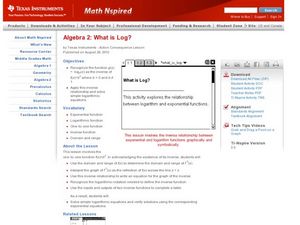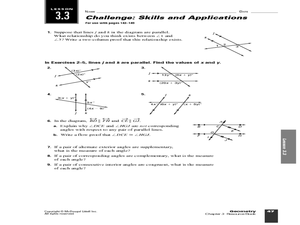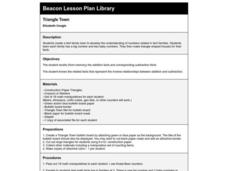Curated OER
Finding Area of Similar Figures
Students explore the concept of finding area of similar figures. In this finding area of similar figures instructional activity, students use pattern blocks to construct similar figures. Students trace their construction and find the...
Curated OER
Secants, Tangents and Arcs
Students identify chords and angles. In this geometry activity, students calculate the length of the chords inside and outside of-the circle. They differentiate between tangent and secant lines.
Curated OER
Angular Size and Similar Triangles
In this angular size and similar triangles worksheet, students use the properties of similar triangles and the ratios of sides to solve for unknowns in given diagrams.
Curated OER
More Problems in Context: Linear Models
Six application problems help students to master their knowledge of linear models. Each problem is cited with the original publication source. These questions could be a good class activity, homework assignment, or incorporated into a quiz.
Curated OER
Using Technology To Teach Parallel Lines With Transversals
Learners explore the relationships between angles formed by two lines cut by a transversal when lines are and are not parallel. They define key vocabulary terms, then using a camera take pictures at their school of parallel lines with...
Curated OER
What is Log?
Young mathematicians differentiate between logs and natural logs in this algebra lesson. They solve functions and logarithmic functions. Learners also graph and rewrite the exponential and log functions.
Curated OER
Triangle Sum Theorem
Tenth graders investigate the theorems of angles and lines to prove triagle sum theorem. In this geometry lesson, 10th graders discuss the theorems of triangles and how it is used to solve for missing sides or angles. They review how two...
Curated OER
Systems of Linear Inequalities
The class solves systems of linear inequalities. They graph lines and identify the point of intersection.They graph lines and identify the boundary that represent the solution and solution set.
Curated OER
Fractions!
Second graders observe and design manipulatives showing fractional parts. In this fractional part lesson, 2nd graders create a paper hamburger using circle fractions. Students navigate a website to find fractional parts of a...
Curated OER
Eagle Nebula - Close-up
In this Eagle nebula worksheet, students solve 4 problems including finding the size of the nebula field, determining the scale of the image, determining how large the nebula is in millimeters and determining the size of the smallest...
NASA
Star Brightness
In this brightness of stars worksheet, high schoolers answer 7 questions about the apparent magnitudes of stars, the sun, and the moon. They compare the brightness of stars, galaxies, astronomical objects and the sun.
Curated OER
Using Tables to Solve Linear Functions
Oh that intercept! Budding algebra masters solve linear equations from standard to intercept form. They identify the slope and y-intercept to help graph the lines, an then create coordinate pairs using a table of values. Great TI tips...
Curated OER
Star Light...Star Bright
For this brightness of stars worksheet, students use a given formula using the temperature in Kelvins of a star to find its brightness. Students solve 4 problems using this equation.
Curated OER
LRO and the Apollo-11 Landing Site
In this Apollo-11 landing site learning exercise, students read about the NASA Lunar Reconnaissance Orbiter (LRO) that will collect images at a higher resolution than ever before. Students study a grid showing the lunar landing site from...
Curated OER
Spherical Geometry: A Global Perspective
Students investigate spherical geometry using a globe and an apple. In this spherical geometry lesson plan, students translate Euclidean geometry terms to spherical geometry terms using a globe. They answer 3 questions about spherical...
Curated OER
Magnetic Storms
For this magnetic storms worksheet, students use a graph of data collected over time showing the magnitude of a magnetic storm. Students use the data to solve 6 problems about the graph and they determine the strength of the storm at...
Curated OER
The Secret of the Crystal Ball
Eighth graders use mathematical expressions to solve problems. In this basic properties of operations, 8th graders use prior knowledge and logical reasoning to solve equations. Students analyze an equation by solving a...
Curated OER
Geometry Practice: Area of Polygons #8
In this area of polygons worksheet, students solve 7 short answer and multiple choice questions about area. Students find the area of triangles given base and height, or points in the coordinate plane.
Curated OER
Regents Exam Questions G.G.26: Inverse 2
For this inverse worksheet, students solve 6 short answer problems. Students find the inverse of a given conditional statement.
Curated OER
The Truth About Triangles And Proofs
Students engage in a lesson that is about the classification of triangles and the mathematical proofs involved in working with them. They work on a variety of problems that are created by the teacher with the focus upon the importance of...
Curated OER
Power Functions: A Question of Magnitude
For this power functions worksheet, students read about determining the brightness of stars using a magnitude scale. Students solve 4 problems including finding the magnitude differences of stars and determining equivalent magnitudes.
Curated OER
Challenge: Skills and Applications Lesson 3.3
In this angle measures worksheet, students solve 9 short answer problems. Students find values for x and y given two parallel lines cut by a transversal. Students use alternate interior, supplementary, and exterior angles to find x and y.
Curated OER
Triangle Town
Second graders create a fact family town to develop the understanding of numbers related in fact families. They learn each family has a big number and two baby numbers. They make triangle shaped houses for their facts.
Curated OER
The Triangles Problem
In this geometry worksheet, 10th graders explain how two triangles can have 5 parts of the other triangle and still not be congruent. This is a word problem with an answer key.

























